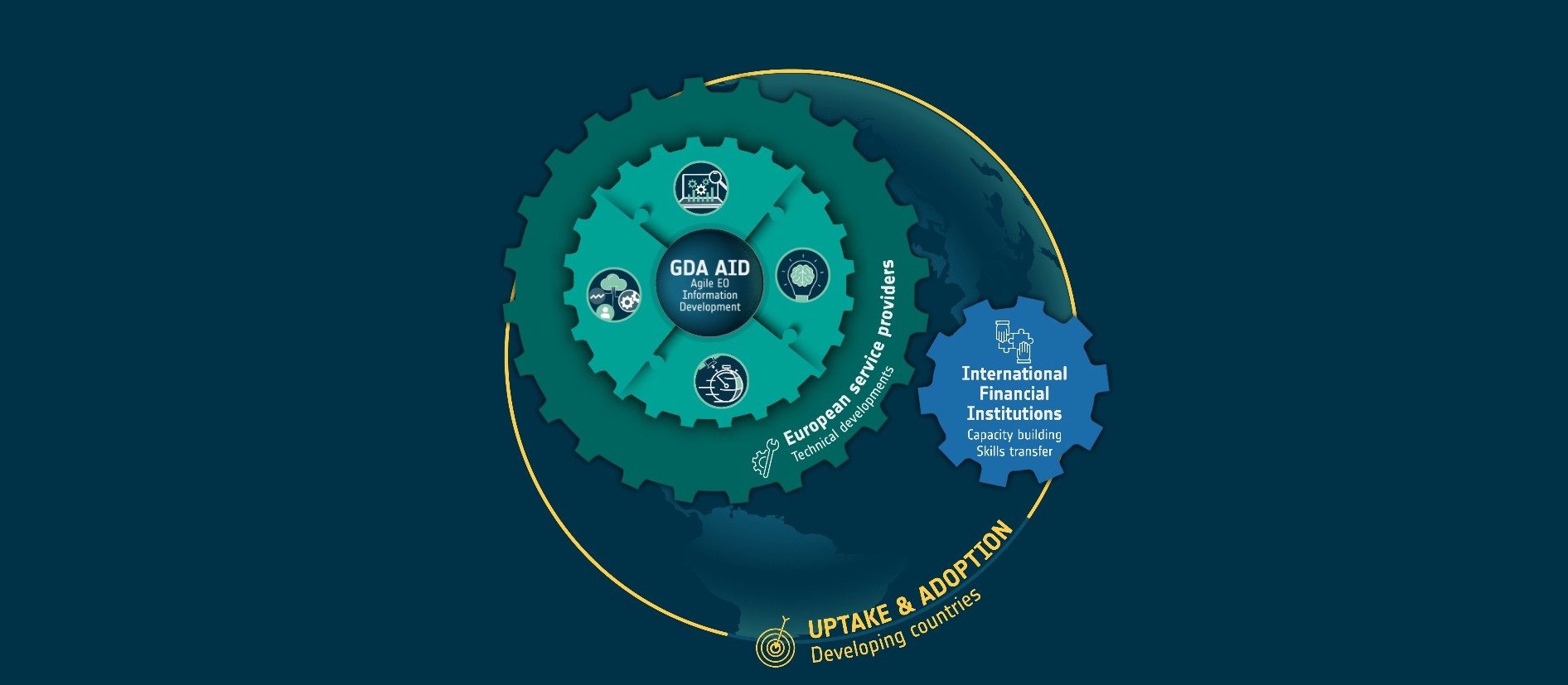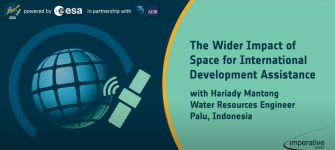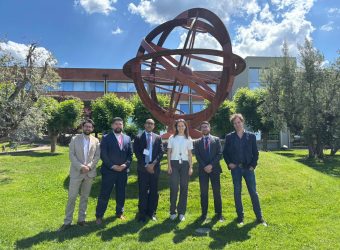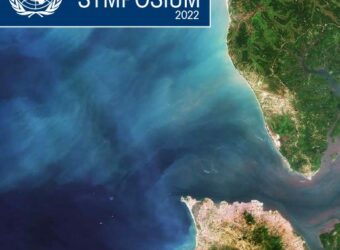Afghanistan’s water resources face increasing pressures from growing demand, climate change, and limited in situ data availability. Through the European Space Agency’s Global Development Assistance (ESA GDA) Fast Co-Financing Facility, Earth Observation (EO) data have provided critical insights to support the World Bank’s Strengthening Food Systems, Water Management, and Climate Adaptation operations. This project exemplifies ESA GDA’s mission to integrate EO into International Financial Institutions (IFI) operations worldwide, demonstrating how EO data can provide scalable, cost-effective solutions to bridge critical data gaps and support evidence-based decision-making. Afghanistan serves as a key case study, showcasing the transformative potential of EO for addressing complex water challenges in regions facing resource limitations and environmental pressures.
Over a 6-month activation, the GDA project delivered three key services to address Afghanistan’s water challenges.
Assessing Groundwater Resources
Groundwater plays a vital role in Afghanistan’s water security. The first service utilised GRACE satellite data to evaluate groundwater storage anomalies (GWSA) and recharge patterns from 2003 to 2022 for Kabul, Kandahar, and Herat. GWSA data supported recharge estimation and drought identification, offering valuable insights into regional water dynamics.
The time-series analysis of GWSA over the study areas reveals a decline in groundwater resources, most pronounced in Herat and least marked in Kabul. Additionally, the long-term groundwater storage anomalies were used to investigate aquifer behaviour, unveiling geographical differences. However, when analysed on an annual basis, the results reveal significant interannual variability, which overshadows these geographical patterns.
Recharge assessments highlighted regional disparities, with higher rates in southern Kabul (200–400 mm/year), moderate rates in Herat (30–200 mm/year), and lower rates in Kandahar (40 mm/year).
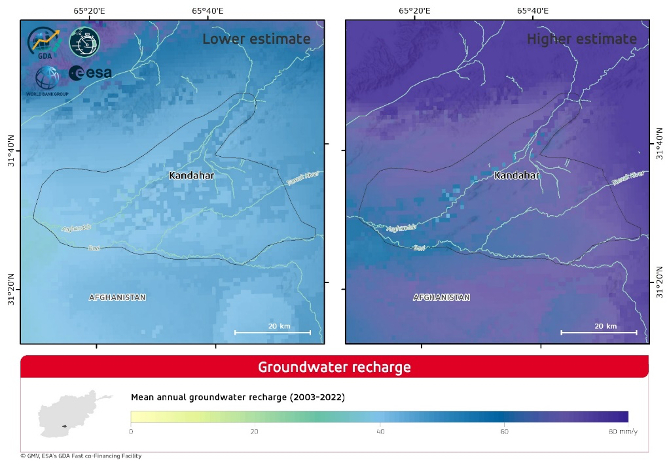
The Grace Groundwater Drought Index (GGDI) suggests an increasing drought severity in recent years, with sustained drought conditions from 2016 onwards in all three areas. Herat experienced an earlier onset, with drought first detected in 2013.
By leveraging EO data, this service enables the identification of long-term trends and monitoring of groundwater dynamics even in regions where conventional in situ measurements are sparse or unavailable. Such capabilities empower IFIs to make informed decisions, addressing water challenges with scalable and adaptable solutions to local contexts. Recommendations included mapping Managed Aquifer Recharge (MAR) suitability and enhancing seasonal analysis of hydrometeorological variables such as precipitation and temperature.
Monitoring Snow Resources
Snow and its meltwater are critical lifelines for Afghanistan’s river systems. Using Earth Observation and model data, this service analysed two decades of snow cover and Snow Water Equivalent (SWE) trends to assess the availability of water stored in snowpacks. The study also evaluated the influence of snowmelt on river flows using runoff data from NASA’s FLDAS and in situ observations.
Results showed a declining snow cover (-0.09% annually) and a 0.37 km³ annual reduction in SWE, with the most significant losses in the Panj Amu basin. The melting period contributes 81–91% of overall yearly runoff, with the Panj Amu basin showing the strongest correlation between SWE and runoff (lag time of 2 days). However, inter-basin variability highlighted the importance of tailored water management strategies, as the Kabul Indus basin exhibited increasing runoff trends while the Panj Amu basin faced declines.
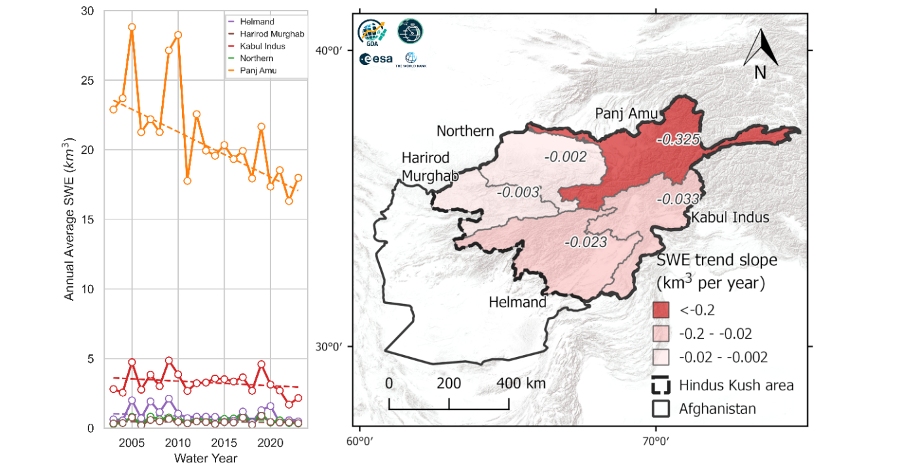
This service harnessed EO data to provide a comprehensive understanding of snow dynamics and their implications for water resources. Assessing trends over large, remote areas offers invaluable insights to inform targeted and adaptive water management strategies. The observed decrease in snowpack in the Panj Amu basin aligns with a documented reduction in glacier area in the region (ICIMOD, 2021), underscoring the interconnected impacts of climate change. Declining snow resources pose significant challenges for agriculture, energy production, and water security in snow-fed basins, making it essential to incorporate these insights into future decisions on infrastructure development and water resource allocation.
Analysing the Water Balance
The third service provided a comprehensive water balance analysis for Afghanistan’s five river basins (2003–2023), incorporating EO data from CHIRPS, IMERG, GLEAM, FLDAS, and GRACE. The remote sensing and model data were compared with precipitation and streamflow in situ data in 8 selected sub-catchments.
Key findings included:
- November to April identified as critical recharge periods
- Evapotranspiration accounting for 62–75% of the water budget
- Snowmelt and glacier runoff sustaining the Panj Amu and Kabul Indus basins, with glaciers contributing up to 73% of Panj Amu’s annual runoff
- Declining terrestrial water storage anomalies (TWSA) and increasing discrepancies between GRACE and FLDAS data, indicating significant groundwater depletion in Helmand and Kabul Indus basins.
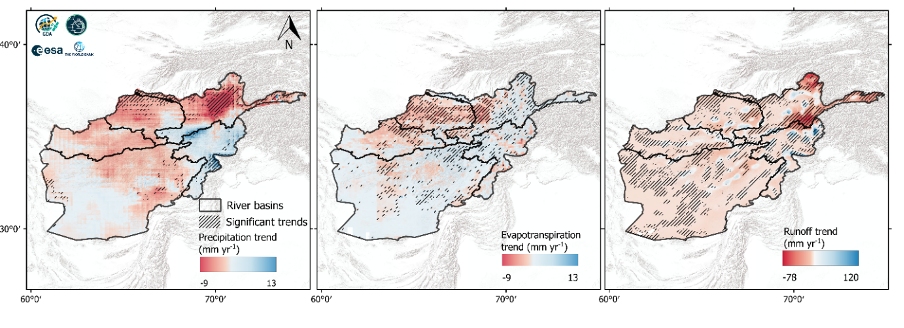
By leveraging EO data, this service provided crucial insights into spatial water availability trends. EO-based water balance assessments offer a unique capability to monitor seasonal and long-term water dynamics across large regions, surpassing conventional in situ measurements.
Path Forward: Advancing Sustainable Water Management
The World Bank team organised a dissemination workshop, bringing together a diverse group of stakeholders from across Afghanistan. The study’s findings were well-received, sparking significant interest in further exploring hydrological processes. Several stakeholders corroborated the conclusions, based on on-the-ground experiences with snow dynamics, water balance components, and groundwater conditions.
The workshop showcased how ESA GDA-supported EO services can bridge the gap between cutting-edge technology and actionable insights, fostering interest among stakeholders in Afghanistan. Such collaborations serve as a model for scaling up EO integration in IFI operations across diverse regions facing water security challenges.
The discussions highlighted strong interest in further exploring:
- Evapotranspiration dynamics, particularly its share of annual precipitation
- Refining groundwater recharge estimations to compare with existing field studies
These topics reflect critical knowledge gaps in Afghanistan’s water management practices. Addressing them could deepen the integration of EO data into decision-making processes.
Uptake of EO in IFI Processes
The findings of this study will directly contribute to the Afghanistan Water Security Diagnostic Report, currently under preparation, strengthening its evidence base with EO-driven insights. In parallel, the World Bank and the broader water community are advancing efforts to institutionalise EO data in decision-making processes by developing dedicated platforms for knowledge sharing and data accessibility, including:
- The Afghanistan Water Platform (AWAP): A professional network fostering collaboration among water experts.
- The Afghanistan Water Informatics Dashboard: A centralised EO-based platform designed to support sustainable water management, agricultural planning, and climate adaptation.
A World Bank representative emphasised the study’s impact, stating:
“This study provided critical insights into the current state of water resources in Afghanistan, including groundwater, snow cover, and river flow, using EO data. These insights will help the World Bank and the wider water community in Afghanistan better understand water resource challenges and guide initiatives to strengthen food systems, water management, and climate adaptation.”
By embedding EO-derived intelligence into IFI processes, these initiatives ensure long-term accessibility and application of EO data, empowering data-driven water governance and climate resilience strategies.
Next Steps
This study serves as a model for scaling up EO data for evidence-based decision-making for water resources management in Afghanistan. The World Bank has already started expanding on this effort by developing the Afghanistan Irrigation Performance Assessment Tool using EO data.
Recognising the need for continued research, stakeholder engagement, and capacity building, these efforts will be essential to sustaining the integration of EO in the water sector and maximising its impact.



